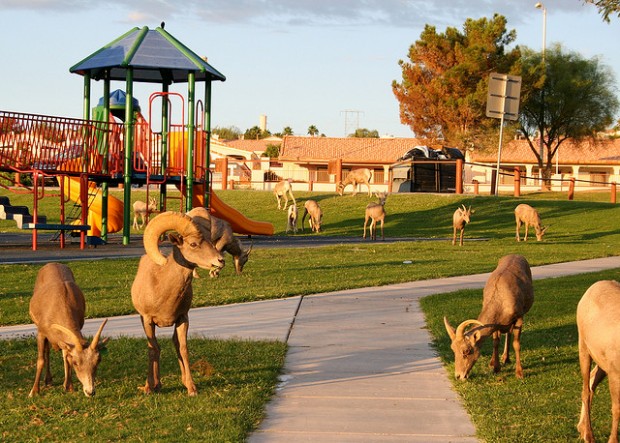In the pre-dawn hour, I’m sitting at a picnic table in a little neighborhood park, a plastic kids playground behind me, thick green lawn reaching across the gentle slope to the east, all of it overlooking the bathtub-ringed reservoir called Lake Mead. Huge jackrabbits sleep on the park’s edge. On the other side, I see the soft slumbering lumps of desert cottontails.
It’s 76 degrees, before the sun rises over the brown-red mountains on the Arizona side. In the dim purple light, I see the first Desert Bighorn Sheep step daintily down the rocky hill and underneath the great metal legs of the electric-transmission tower behind this Boulder City suburban park. It’s a tall ram with huge winding horns. A half-dozen more follow him down. They cautiously look around the empty park and settle in for breakfast.
Magnificent creatures! The males are huge and sturdy, the patriarchs with thick curling horns that wrap down and around the head, some ending with ragged points from their mating wars. Long ears, horselike muzzles neatly capped in white hair, huge calm eyes, the short rough coat exactly the color of the desert rocks they call home, and here they are in a suburb.

I have come here after driving across the Eastern Mojave on the back roads and spending the night in a lonely motel court, just to greet these sheep in this ridiculous situation.
They are here for the grass, coming down from their rocky perches between stucco desert homes overlooking the reservoir. I count eighteen sheep now, but more are on the way.
The bighorn is a famously shy creature, rarely seen even by dedicated desert hikers who scramble up jagged slopes in hopes of spotting a small, distant herd. I have slept on the hard ground in Anza-Borrego hoping to see them on their dawn patrol, and found nothing but their droppings at the bottom of vertical rockslide slopes they climb with ease.
Now, as the sun makes its melodramatic appearance over the still water, there are thirty bighorn grazing alongside a basketball court. I am surrounded, and the only sound comes from their jaws working the sweet green irrigated grass—and the distant rumble of semi trucks now lumbering up U.S. 93 from the Arizona side. A white-haired jogger appears at the edge of the park. Some kind of local government vehicle parks alongside my car, and two workers bring their coffee to the next picnic table over. The wild sheep separate to make a path for the uniformed men, who sit quietly sipping their breakfast, and then leave without a word.
Built by the U.S. government for the people who built Boulder (now Hoover) Dam during our previous Great Depression, Boulder City today is the last link in the Las Vegas chain of suburbs. It’s a quaint town of charming 1930s cottages on small lots surrounding a pleasant city park, civic buildings and a single-street business district of restaurants and Indian Jewelry shops. And if you drive here from the south, on U.S. 95 along the eastern edge of Mojave National Preserve, you can avoid Vegas altogether.
This extraordinary scene with these rare mountain sheep is just a few minutes down the road from the center of town. The park is surrounded by stucco ranch homes facing poor old Lake Mead, filling up with sediment, a dirty gray ring showing how much the reservoir has shrunk during our endless southwest drought. The highway is just a hundred yards away, utility towers stretching for miles along their corridors, and signs explain that the old restaurant and lounge on the corner will soon be a senior-living home.
This is the natural world gone haywire. What is happening here? No predators? Is there not a brave mountain lion or pack of coyotes that could use a little sheep protein? A hungry bum?
I’m crouched on the cement walkway as the herd grows. I take pictures and stay still and quiet, the camera shutter sounding like a machine gun in this silence. They chomp their grass and occasionally glance up. A younger ram butts horns with another. A trio of juvenile sheep nervously graze inches from my boots, their mother watching me warily. Good lord, is that ewe wearing a faded red dog collar?
There are sixty now. Sixty! Something I cannot hear startles the herd and it moves like low thunder over the green expanse, settling by the rocks on the north end of the park—an insane safari scene, with chain link and picnic tables and power lines as the backdrop, along with the parched rocky mountains and purple-blue clouds that grow redder and brighter with the rising sun.
The Bighorns have been a local attraction for years now, in this banal public park of tennis courts and picnic spots for toddlers’ birthday parties and outdoor weddings and weekend barbecues. But the herd has grown untenable over this long summer, occasionally even wandering down to the highway and stopping traffic.
Nevada’s Department of Wildlife will forcibly remove part of this huge herd this fall, and transfer them by helicopter to Lincoln County, where the Bighorn must make do with their regular diet of wild grasses, and their regular predators.
Good luck, sheep!
Ken Layne is the editor of Greenfriar. This piece was originally published by Los Angeles CityBeat in October 2008.
